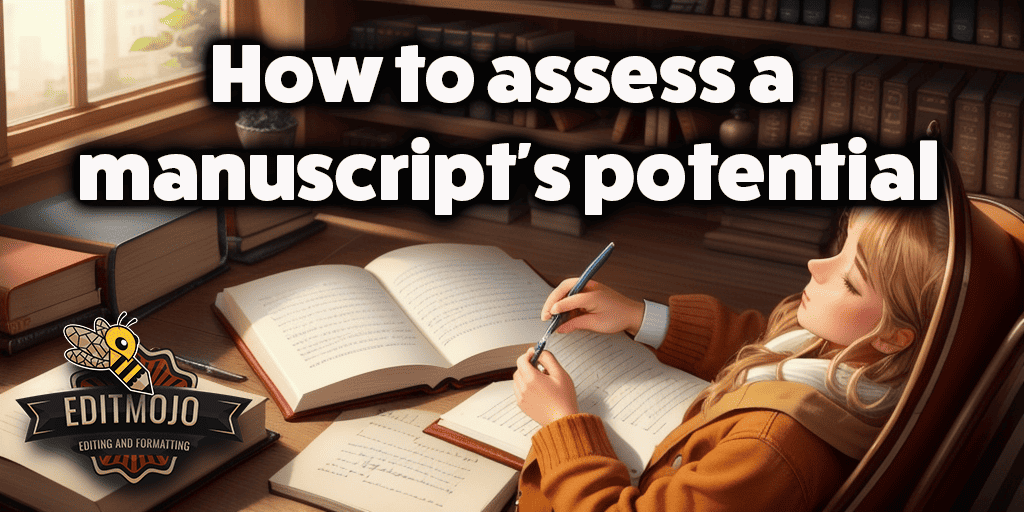How to assess a manuscript’s potential
How to Assess a Manuscript‘s Potential. If you’ve ever found yourself on the brink of the exciting yet daunting task of assessing a manuscript’s potential, you’re in the right place. Whether you’re an emerging editor, a literary agent, or just a book enthusiast looking to dive deeper into the literary realm, this guide will be your roadmap to successfully navigating the uncharted territories of manuscript evaluation.
Identifying Your Manuscript’s Genre
Step one in your journey is identifying your manuscript’s genre. Are you dealing with a fast-paced thriller, a heartwarming romance, or a cutting-edge sci-fi? Recognizing the genre is crucial because it sets the stage for the expectations and norms that you’ll be applying during your assessment. Writer’s Digest provides a handy guide to understanding different genres.

Assessing the Hook
Next, let’s talk about the hook. This is the opening of the book, the first taste that readers get of the world you’re inviting them into. Is it engaging? Does it leave you curious and yearning for more? If it doesn’t, then chances are it might not do so for your readers either. Check out this article for a deeper dive into what makes a good hook.
Character Analysis
Diving into the heart of the manuscript, we arrive at character analysis. Characters are the lifeblood of any story, and their development (or lack thereof) can significantly impact the manuscript’s potential. Are the characters relatable, well-rounded, and evolving? This guide by Reedsy can help you evaluate character development effectively.
Plot Evaluation
Moving on, let’s delve into the plot. Is the story compelling and well-paced? Are there enough twists and turns to keep readers engaged? Does the story culminate in a satisfying conclusion? Evaluating the plot is paramount when assessing a manuscript’s potential. The elements of a good plot by MasterClass can give you a better understanding of this aspect.

Writing Style and Tone
Last, but by no means least, consider the writing style and tone. Is the language evocative and immersive? Does the tone match the content and genre of the book? The manuscript’s overall readability and linguistic quality can greatly influence its appeal. The University of North Carolina’s Writing Center offers an excellent resource on style and tone.
By the end of this comprehensive journey, you should be well-equipped to gauge a manuscript’s potential effectively. Remember, there’s no one-size-fits-all approach to this. It requires a delicate balance of analytical prowess, a deep understanding of literary elements, and, most importantly, trust in your instincts.
So the next time you find yourself holding a manuscript, remember this guide and start uncovering those hidden literary gems. Happy reading!

Looking Beyond the Surface: Delving Deeper Into Manuscript Assessment
The initial steps we’ve outlined offer a strong foundation for assessing a manuscript’s potential. But, as any seasoned editor will tell you, the deeper you dig, the more you uncover. Let’s expand our toolbox and learn to assess the potential of a manuscript with even greater precision.
Theme and Symbolism
The heart of any great book lies in its themes and symbols. These are the underlying messages or symbols that give the story depth and meaning. Are the themes thought-provoking and relevant? Is symbolism used effectively to enhance the story’s impact? The British Library provides an insightful overview of theme and symbolism that can be a useful reference.
Voice and Dialogue
A manuscript’s voice and dialogue can significantly contribute to its overall appeal. Is the narrative voice distinctive and engaging? Does the dialogue sound natural and help to develop characters and advance the plot? Check out this guide from MasterClass on how to assess dialogue effectively.
Setting and World-Building
For many genres, especially fantasy and sci-fi, setting and world-building are crucial. Is the setting vividly described? Is the world well-constructed and believable? For a detailed guide on assessing world-building, consider this article from Reedsy.
Conflict and Resolution
Conflict and its resolution form the backbone of most stories. Is the conflict compelling and does it drive the plot forward? Does the resolution provide a satisfactory conclusion to the conflict? To better understand conflict and resolution, Writer’s Digest has a great article.
Marketability and Audience Appeal
Finally, consider the manuscript’s marketability and audience appeal. Is there a target audience who will be interested in this story? How does the book compare to other successful books in its genre? For more on assessing marketability, this post from The Balance Careers is a helpful resource.
Remember, assessing a manuscript’s potential is as much an art as it is a science. It requires not only understanding and applying these tools but also combining them with your intuition and personal judgment. With practice and patience, you’ll soon be able to spot a promising manuscript from a mile away. So, get ready to dive into your next literary adventure!
